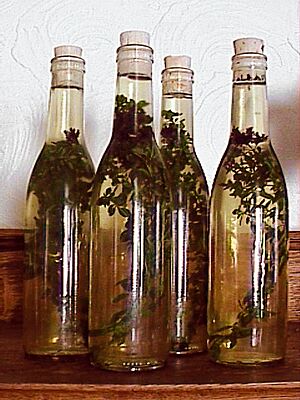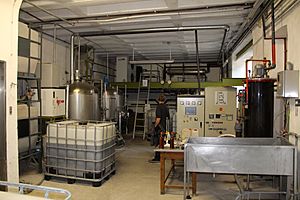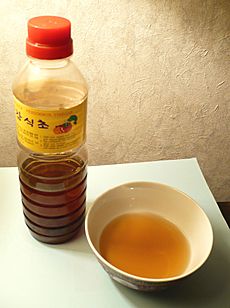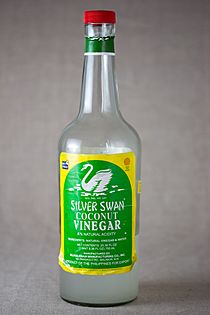Vinegar facts for kids
Vinegar is a liquid that is mostly water and acetic acid. People use it a lot in cooking. You can make vinegar from wine or other liquids that have alcohol, such as cider or fermented fruit juices. The alcohol in these liquids changes into acetic acid, creating vinegar.
In the kitchen, vinegar is often used as a condiment. You can add it to salads, fish, french fries, and vegetables like pickles and cabbage. It's a key ingredient in many salad dressings.
Vinegar made from dates is a very old product from the Middle East. Special bacteria can also help make vinegar. Vinegar usually contains about 5% acetic acid, which gives it its sour flavor.
The pH level of vinegar depends on how much acid it has. Apple cider vinegar, when not mixed with water, usually has a pH between 4.25 and 5.00. Distilled vinegar has a pH of about 2.4, making it more acidic.
Contents
What Does the Word "Vinegar" Mean?
The word "vinegar" came into English from an old French phrase, vyn egre. This meant "sour wine." This French phrase came from Latin words: vīnum (wine) and ācer (sour). So, "vinegar" literally means "sour wine."
The History of Vinegar
People have been making and using vinegar for a very long time. The first records show that the ancient Babylonians used it around 3000 BC. They made vinegar from dates, figs, and beer. They used it for cooking and also as medicine. Scientists have even found traces of vinegar in old Egyptian jars. In East Asia, the Chinese started making vinegar professionally during the Zhou dynasty.
The ancient Greeks and Romans often used vinegar made from wine.
In the late Middle Ages, making vinegar slowly became a professional skill in Europe. The French city of Orléans became famous for its high-quality vinegar. They developed a special way of fermenting and aging it, called the Orléans process. Around this time, malt vinegar also started to be made in England. It was first known as alegar. Balsamic vinegar also began to develop in Italy, in the Duchy of Modena. However, it didn't become widely known until the Napoleonic Wars, when French soldiers sold it to other countries.
In the 1800s, vinegar production became much more industrial. By the 1900s, it only took 1 to 2 days to make vinegar. This made it possible to produce large amounts of cheap vinegar all over the world.
Types of Vinegar
Vinegar can be made from many different things. These include various fruits, grains, alcoholic beverages, and other materials that can ferment.
Fruit Vinegars

Fruit vinegars are made from fruit wines. They usually keep the flavor of the original fruit. Some common fruit vinegars are apple, blackcurrant, raspberry, quince, and tomato. Most fruit vinegars are made in Europe. There, people like to buy expensive vinegars made only from specific fruits.
Several types are also made in Asia. Persimmon vinegar, called gam sikcho, is popular in South Korea. Jujube vinegar, called zaocu or hongzaocu, and wolfberry vinegar are made in China.
Apple cider vinegar is made from cider or apple must (crushed apples). It has a brownish-gold color. Sometimes, it's sold unfiltered and unpasteurized, meaning it still contains the "mother of vinegar" (a harmless substance). You can mix it with fruit juice or water, or sweeten it with honey, to drink it.
When kiwifruit are grown for sale, many misshapen or rejected fruits are left over. These can be up to 30% of the crop. One way to use these leftover kiwifruits is to make kiwifruit vinegar. This has been made commercially in New Zealand since the early 1990s and in China since 2008.
Vinegar made from raisins is used in Middle Eastern cooking. It looks cloudy and is medium brown, with a mild taste. Vinegar made from dates is a traditional product of the Middle East, especially in Eastern Arabian cuisine.
Palm Vinegars
Coconut vinegar is made from fermented coconut sap or coconut water. It is used a lot in Southeast Asian cooking, especially in the Philippines, where it's called sukang tuba. It's also used in some parts of India and Sri Lanka, particularly in Goan cuisine. It is a cloudy, white liquid with a very sharp, sour taste and a slightly yeasty smell.
In the Philippines, other types of vinegar are made from palm sap. These are also by-products of making tubâ (palm wine). Two common types are nipa palm vinegar (sukang nipa) and kaong palm vinegar (sukang kaong). Along with coconut and cane vinegar, these are the four main traditional vinegars in the Philippines and are very important in Filipino cuisine. Nipa palm vinegar is made from the sap of nipa palm leaf stalks. It has a citrus flavor and a distinct musky smell. Kaong palm vinegar is made from the sap of kaong palm flower stalks. It is sweeter than other Philippine vinegars and is often used in salad dressings. Vinegar from the buri palm sap is also made, but it's not as common as coconut, nipa, and kaong vinegars.
Balsamic Vinegar
Balsamic vinegar is a flavorful, aged vinegar made in the Modena and Reggio Emilia regions of Italy. The original, traditional balsamic vinegar is made from the thick juice of white Trebbiano grapes. It is dark brown, rich, sweet, and complex. The best kinds are aged for 12 to 25 years in different wooden barrels, like oak, mulberry, chestnut, cherry, juniper, and ash.
Traditional balsamic vinegar used to be very expensive and only available to rich Italians. It is marked tradizionale or "DOC" to show it's a special product from a specific place. A cheaper version, called aceto balsamico di Modena, became popular worldwide in the late 1900s. This is usually made by mixing concentrated grape juice with strong vinegar, then coloring and sweetening it with caramel and sugar.
Balsamic vinegar comes from grapes. It doesn't contain any balsam, even though it was traditionally aged in balsam wood at one point. It has a high acid level, but the sweetness of other ingredients makes it taste smooth. Balsamic vinegar has more carbohydrates from grape sugars (about 17%) than regular distilled or wine vinegar. This means it has about five times more calories.
Cane Vinegar
Vinegar made from sugarcane juice is traditional and most popular in the Philippines. It's especially common in the northern Ilocos Region, where it's called sukang Iloko. It can be dark yellow to golden brown and has a mild flavor, similar to rice vinegar but with a "fresher" taste. It's not sweet because it has no leftover sugar. In the Philippines, it's often called sukang maasim (which means "sour vinegar" in Tagalog).
Cane vinegar is also made in other countries, like France and the United States. A white version has become popular in Brazil because it's the cheapest type of vinegar there. Sometimes, other vinegars (like wine, rice, and apple cider vinegar) are mixed with cane vinegar to make them cheaper.
Sugarcane sirka is made from sugarcane juice in parts of northern India. In summer, people put cane juice in clay pots with iron nails. Wild yeast causes the juice to ferment and turn into a blackish vinegar. This sirka is used to preserve pickles and flavor curries.
Grain Vinegars
Malt vinegar, also called "alegar," is made from ale. First, barley is malted, which turns the starch in the grain into maltose. Then, an ale is brewed from the maltose, and it's allowed to turn into vinegar. After that, it's aged. It's usually light brown. Malt vinegar (with salt) is a traditional seasoning for fish and chips. In the United Kingdom and Canada, it's also a popular seasoning for French fries.
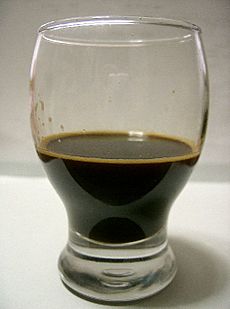
Chinese black vinegar is an aged product made from rice, wheat, millet, sorghum, or a mix of these. It's very dark, almost black, and has a complex, malty flavor. The recipe can vary, so some Chinese black vinegars might have added sugar, spices, or caramel color. The most famous type, Zhenjiang vinegar, comes from the city of Zhenjiang in Jiangsu Province, eastern China. Shanxi mature vinegar is another popular Chinese vinegar made only from sorghum and other grains. Some traditional workshops in Shanxi province still make handmade vinegar with high acidity that is aged for at least five years.
Rice vinegar is very popular in East and Southeast Asian cooking. It comes in "white" (light yellow), red, and black types. Japanese people prefer a light rice vinegar for making sushi rice and salad dressings. Red rice vinegar usually gets its color from red yeast rice. Black rice vinegar (made with black glutinous rice) is most popular in China and widely used in other East Asian countries. White rice vinegar has a mild, simple flavor. Some rice vinegars are sweetened or flavored with spices.
Spirit Vinegars
The term "spirit vinegar" sometimes refers to a stronger vinegar (5% to 24% acetic acid) made from sugar cane or from acetic acid made chemically. To be called "spirit vinegar," it must come from a farm product and be made by "double fermentation." First, sugar turns into alcohol, then alcohol turns into acetic acid. In the UK, products made from chemically produced acetic acid cannot be called "vinegar." They are called "non-brewed condiment."
Sherry vinegar is connected to the making of sherry wines in Jerez, Spain. It's dark brown and made only from the fermentation of wines. It has strong aromas, including a hint of wood. It's great for salad dressings and flavoring many foods. Wine vinegar is made from red or white wine. It's the most common vinegar in Southern and Central Europe, Cyprus, and Israel. Like wine, its quality can vary a lot. Better wine vinegars are aged in wood for up to two years and have a complex, smooth flavor. Wine vinegar usually has less acid than white or cider vinegars. More expensive wine vinegars are made from specific types of wine, like champagne, sherry, or pinot gris.
"Distilled vinegar" in the United States (called "spirit vinegar" in the UK, "white vinegar" in Canada) is a bit of a confusing name. It's not made by distillation, but by fermenting distilled alcohol. The fermented liquid is then watered down to create a clear liquid with 5% to 8% acetic acid. It has a pH of about 2.6. This is also known as "virgin" vinegar or white vinegar. People use it for cooking, baking, preserving meat, and pickling. It's also used for medicine, in labs, and for cleaning. In some places, the cheapest starting material is barley malt, or in the United States, corn. Sometimes, it can even come from petroleum. Distilled vinegar is mainly used for cooking, but in the UK, it's also used instead of brown or light malt vinegar. White distilled vinegar is also great for cleaning, and some types are sold just for that purpose.
How Vinegar is Used in Cooking
Vinegar is often used in food preparation. It's common in pickling liquids, vinaigrettes, and other salad dressings. It's also an ingredient in many sauces, like hot sauce, mustard, ketchup, and mayonnaise. Vinegar is sometimes used in chutneys. It can be a condiment on its own or part of other condiments. Marinades often contain vinegar. Some Soups, like hot and sour soup, also have vinegar added to them.
Vinegar in Drinks
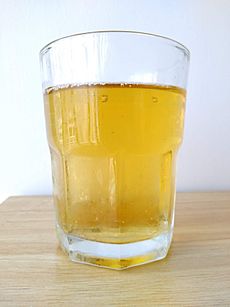
Several drinks are made with vinegar. For example, posca was a drink in ancient Rome. The ancient Greek drink oxymel is made from vinegar and honey. sekanjabin is a traditional Persian drink similar to oxymel.
Other drinks, sometimes called "shrubs," can be simple. They might just be sugar water or honey water mixed with a little fruity vinegar. Or, they can be more complex, made by soaking fruit or mint in vinegar for several days. Then, the solids are sieved out, and a lot of sugar is added. Some people boil the "shrub" at the end. These old recipes are not as popular now because of carbonated beverages like sodas.
Vinegar and Nutrition
Distilled or red wine vinegar is about 95% water. It has no fat or protein. In a 100 mL serving, distilled vinegar provides about 18 calories and no important micronutrients. Red wine vinegar and apple cider vinegar have similar nutrition. However, balsamic vinegar is 77% water and 17% carbohydrates. It has about 88 calories per 100 mL and no fat, protein, or micronutrients.
How much sugar does vinegar contain?
Vinegar is generally low in sugar, but the exact amount varies depending on the type. Here's a breakdown:
Distilled White Vinegar
Contains only trace amounts of carbohydrates (0.1g per cup) and no sugars. It is primarily acetic acid and water.
Apple Cider Vinegar
Approximately 0.9-1g of sugar per tablespoon (varies by brand).
Balsamic Vinegar
Higher than other vinegars, typically 4-8g of sugar per tablespoon (from natural grape sugars).
Red Wine Vinegar
Nearly zero (0g per tablespoon). Fermentation converts sugars from wine into acetic acid, leaving minimal residual sugar.
Other Varieties (e.g., Rice Vinegar, Malt Vinegar)
Typically 0-1g per tablespoon. Flavored or fruit-infused vinegars may have slightly higher sugar.
Vinegar in Folk Medicine
For a long time, people have used vinegar in folk medicine. However, there is no strong scientific proof from research that it helps with diabetes, weight loss, cancer, or as a probiotic. One study suggested it might help people with type 2 diabetes lower insulin and glucose levels after meals.
Some ways of using vinegar for health can be risky. There have been reports of esophageal (throat) injury from apple cider vinegar. Also, vinegar products sold for medicine are not regulated, so their content and acidity can vary a lot.
Vinegar for Cleaning
White vinegar is often used to clean homes. For most cleaning tasks, it's best to mix it with water. This makes it safer and helps prevent damage to surfaces. Because vinegar is acidic, it can dissolve mineral deposits from glass, coffee makers, and other smooth surfaces. Vinegar is known to clean stainless steel and glass well. In the United Kingdom, a traditional way to clean greasy windows and mirrors is to sprinkle malt vinegar onto crumpled newspaper.
Vinegar can also be used for polishing copper, brass, bronze, or silver. It's great for cleaning epoxy resin and the sticky gum from price tags. Some people even say it's good for cleaning drains.
However, using vinegar in dishwashers and washing machines can damage their rubber seals and hoses, which might cause leaks. According to tests by Consumer Reports, vinegar isn't good as a rinse aid or for removing hard-water film in a dishwasher. Brian Sansoni, a spokesperson for the American Cleaning Institute, says vinegar "isn't very useful with stains that have already set into clothing, including food stains and bloodstains." Other household items and surfaces that can be damaged by vinegar include flooring, stone countertops, knives, electronic device screens, clothes iron water tanks, and rubber parts of various small appliances. Common metals that can be damaged by vinegar include aluminum, copper, and lower-quality stainless steel often used in small appliances.
Other Uses for Vinegar
Twenty percent acetic acid vinegar can be used as a herbicide (something that kills plants). However, acetic acid doesn't get absorbed into plant roots. So, the vinegar will only kill the top part of the plant, and perennial plants might grow back.
Putting vinegar on common jellyfish stings stops the stinging cells (nematocysts) from working. Hot water works even better. This also applies to the Portuguese man o' war, which is often thought to be a jellyfish but is actually a siphonophore.
Cool Facts About Vinegar
- Vinegar used to be called eisel.
- Louis Pasteur made an important discovery. He found that a special type of bacteria, later called acetic acid bacteria, was responsible for turning alcohol into vinegar.
- Karl Sebastian Schüzenbach invented the first large-scale way to produce vinegar in factories in the Kingdom of Baden in 1823.
- The Japanese company Mizkan, located in Handa, is the biggest vinegar producer in the world.
- Vinegar lasts a very long time without needing a refrigerator. Its acidic nature means it's already "spoiled" in a way, so it doesn't really go bad.
- Research suggests that having 2–4 tablespoons of vinegar might slightly lower blood glucose and insulin levels after meals for people with diabetes.
- Most commercial vinegar solutions for home use are not stronger than 5%. Solutions above 10% need to be handled carefully because they can be harmful to skin.
- When a bottle of vinegar is opened, a slimy substance called "mother of vinegar" might grow. It's harmless and can be removed by filtering.
- The government of Canada says that vinegars must have between 4.1% and 12.3% acetic acid, unless they are sold only for manufacturing.
Images for kids
-
Chinese black vinegar.
See also
 In Spanish: Vinagre para niños
In Spanish: Vinagre para niños


